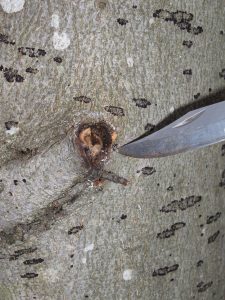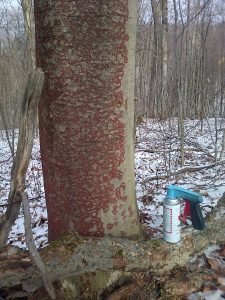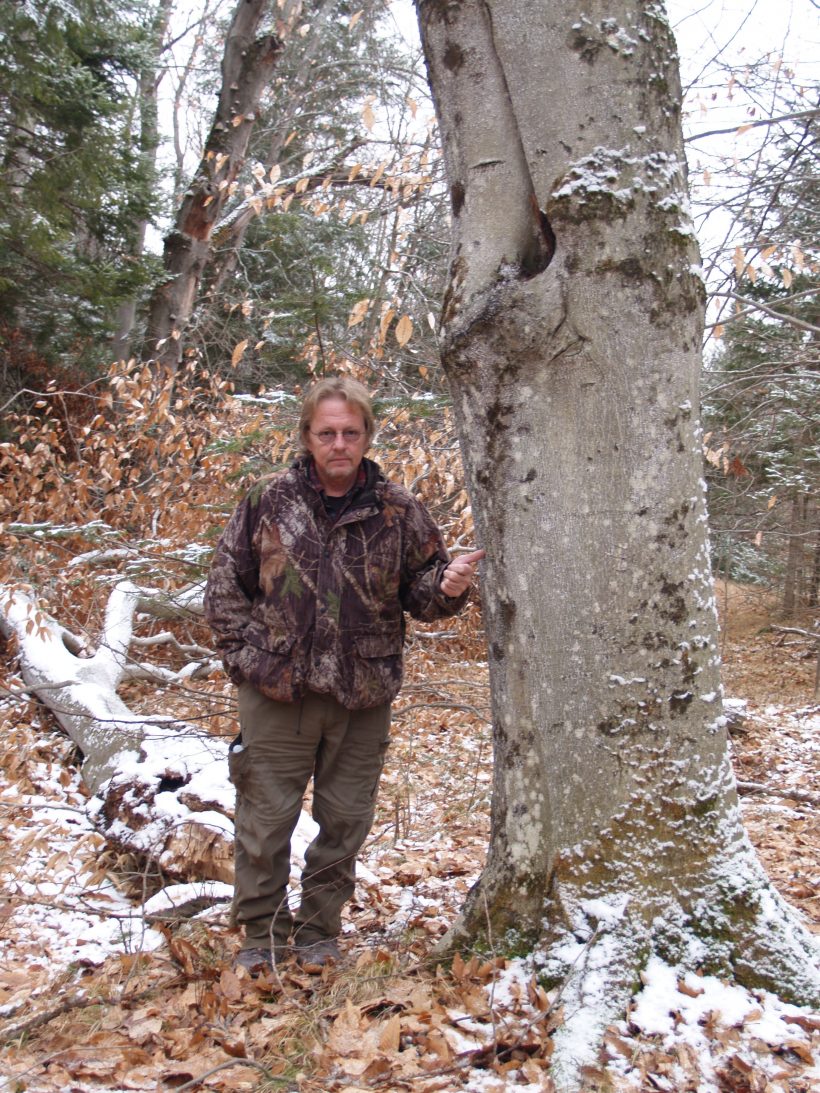BEECH BARK DISEASE by BARNEY MOORHOUSE For Reproduction Rights Call Access 1.800.893.5777
Recently I spent some time with Doug Thain of Lakeside Forestry wandering through a beech grove examining trees suffering from Beech Bark Disease. Landowners may not be up to speed on this most destructive beech ailment. When all is said and done the infected trees are basically only suitable for firewood which splits very nicely if you know the technique. (A timely twist of the wrist as the downward stroke strikes the wood.)
Information from the Ministry of Natural Resources and Forestry (MNRF) states that our American beech is one of the seven principal tree species comprising Ontario’s tolerant hardwood forests. Readers probably remember being introduced to the beech by someone suggesting that the bark resembles elephant skin and perhaps even pointing out where black bear had stretched upwards and scratched the sensitive bark. These trees can live 250 years with a maximum diameter of 80 cm (approximately 30+ inches) and 27m (approx. 90 feet). They can be found in pure stands but more commonly in mixed stands of sugar maple, yellow birch and hemlock. Historically, beech wood has been used in flooring, furniture, railway ties, pulp and fuelwood. Thain said Budweiser beer used to advertise that their beer was aged in beech barrels for the beechwood taste.

At one point we were in a predominately beech grove badly infected by
Beech bark disease (BBD). Beech bark disease comes in the form of a one-two punch. First a non-native insect, or bug called the beech scale, attacks and feeds on the tree’s outer bark. (This is referred to as the ADVANCING FRONT.) Introduced to North America in the 1890s among European beech seedlings shipped from Europe to Halifax the scales usually first attack older, mature beech trees creating openings to the interior and although they do not kill the tree they do reduce its vigour and growth while lowering the tree’s resistance to fungal infection. Younger beech have a smoother bark which makes the tree less susceptible.
Enter the canker fungus which the MNRF said probably arrived in North America in a way similar to the scale bug. It delivers the knockout punch and is referred to as the KILLING FRONT.
This dynamic duo which comprise the Beech bark disease have gradually spread throughout eastern North America. In 1999, BBD was officially confirmed in Ontario where it continues to spread, mainly via the wind. Which partly explains why it spreads so readily where so many trees are gathered. In fact, beech scale was first reported in Elgin County in 1966. In 1981 beech scale and canker fungus were observed in the Toronto area but the fungus was not identified at that time. It was not officially confirmed to exist in Ontario until 1999, as mentioned earlier.
Within 2 to 10 years of the arrival of the scale insect the feeding wounds become infected with the fungus that grows into and can kill the tree’s inner bark and cambium. Thain likens the scale to minute particles of white lint in appearance. Subsequently, the fungus infection takes on a reddish colour that is more distinctive.

Adult beech scale are small, oval insects about 1 mm in length. During the summer, adults lay eggs on the bark of infested trees. In about 20 days the eggs hatch into the crawler stage. The crawlers, which are the only mobile life stage of the scale, search for new feeding sites in bark cracks and crevasses. Most crawlers do not disperse very far but some can be transported by wind, birds, animals and people (on firewood) resulting in long range dispersal. Once the crawlers begin to feed they produce a protective coating of white wax filaments and remain stationary the rest of their lives. The following spring crawlers moult into adults that continue to feed in place.
Next comes the invasive canker fungus evidenced by conspicuous clusters of tiny bright red fruiting bodies that erupt through the bark killed by the fungus. Spores produced in those fruiting bodies are released during moist, above-freezing conditions during the fall and winter. The spores are dispersed by the wind and water to new infection sites either on the same tree or to nearby scale-infested trees. Most cankers are produced in the fall and continue to grow annually as the fungus invades more bark tissue. Following the canker fungus, many beech die within 3 to 6 years. What remains is referred to as the AFTERMATH FOREST in which you will see stem breakage in the older trees as they decline. Younger trees will become infected and gradually decline as well.
Winter temperatures remaining above -25 degrees C favour the build up of beech scale populations. Several years of drought reportedly increase beech susceptibility to BBD as well.
As of 2012, BBD has spread throughout most of the area in which beech occurs in Ontario. Heavy root sprouting and seedlings can occur around dead and dying trees but these become infected and highly defective. Trees that have lost more than 25% of their crown produce fewer seeds. Although a tree may produce a larger “stress” crop when initially infected U.S. studies indicate that the nut crops of infected trees decline as the tree declines according to the MNRF.
Needless to say this impacts food sources for wildlife such as bear, deer, rodents and birds not to mention habitat for cavity-nesting birds and mammals. Dr. Martyn Obbard, bear specialist with the MNRF, said that the loss of beech trees will have a negative impact on black bear reproductive success and survival due to the loss of the beech nut crop.
ALL IS NOT LOST
Not all beech trees succumb to BBD. Although rare, these trees are DISEASE RESISTANT, found in approximately 1% of beech in North America. Also rare are DISEASE TOLERANT trees that have suffered superficial damage only. This doesn’t mean that they are “home-free.” They may have survived due to positive tree vigour and environmental conditions. They aren’t “out of the woods” as other stressors such as drought, insect defoliation or root disease may render them vulnerable to BBD during a subsequent attack.
The MNRF advises, “Do not transport firewood or logs during the scale’s crawler stage (midsummer to late fall).”
As BBD has existed only a short while in Ontario its long-term effects on stand composition and ecosystem function remain unknown. Observations from other jurisdictions indicate that the effects will be variable. In short, promoting retention of potentially resistant beech through gradual and selective removal of defective, diseased trees plus suppression of susceptible beech regeneration might prove the most effective, long-term management approach. (MNRF)
There are many questions concerning BBD. According to the MNRF it may be up to a century before the long-term effects of BBD on Ontario’s hardwood forests are realized. Continued monitoring of the disease and ecosystem change is needed to effectively tailor management actions for BBD at the stand and landscape level. Tree markers have been instructed to mark smooth-barked trees with little or no scale with a B in blue paint.
I did read that a dormant spray of lime sulphur “takes care of most of the beech scale bugs” and therefore, possibly, the disease. Do your homework. Check it out. And should it be effective one would have an effort worthy of Sisyphus considering the enormity of one tree, let alone an entire stand.
2016
